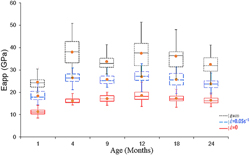Published online by Cambridge University Press: 04 June 2014

The aim of this study is to assess the time-dependent mechanical properties of rat femoral cortical bone in a lifespan model from growth to senescence. New nanoindentation protocol was performed to assess the time-dependent mechanical behavior. The experimental data were fitted with an elastic–viscoelastic–plastic–viscoplastic mechanical model allowing the calculus of the mechanical properties. Variation of mechanical response of bone as a function of the strain rate and age were highlighted. The most representative variations of the mechanical properties with age were found to be statistically significant (P < 0.001) from 1 to 4 months for elastic properties, from 1 to 9 months for viscoelastic properties and during all lifespan for plastic and viscoplastic properties, highlighting different maturation ages for elastic, viscoelastic, plastic and viscoplastic behaviors. These results suggest that different physical–chemical and structural processes occur at different ages reflecting bone modeling and remodeling activities in the rat's whole lifespan.